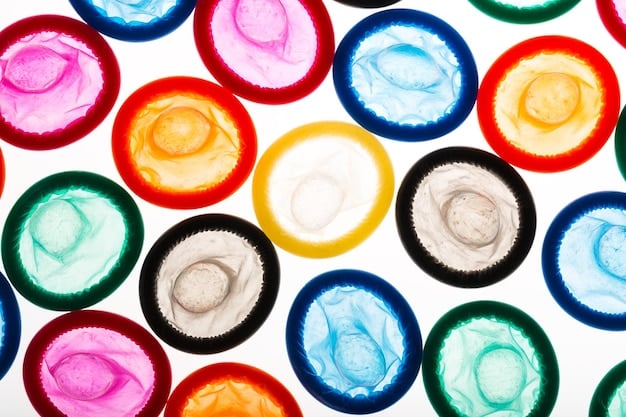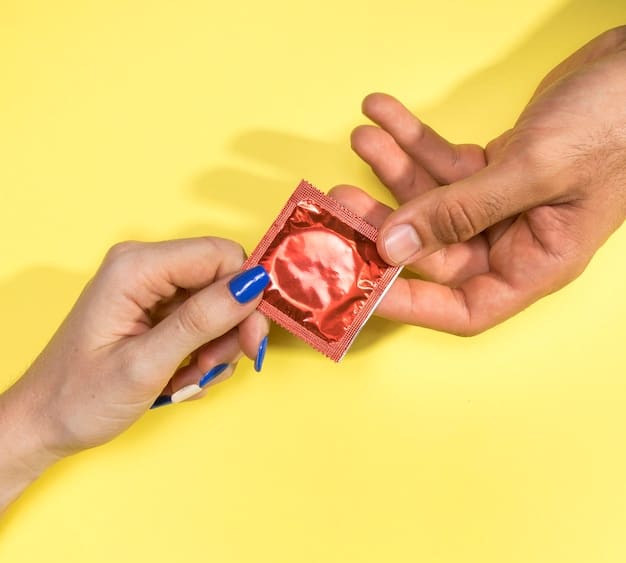Choosing the Right Condom: Protection and Pleasure Guide

Choosing the right condom is essential for effective contraception and STI prevention, while also enhancing sexual experience; understanding the various types, materials, and sizes ensures both safety and comfort for all users.
Navigating the vast array of options when selecting a condom can feel daunting, yet understanding how to choose the right condom for maximum protection and pleasure is a crucial step towards safer and more satisfying sexual health practices. This guide aims to demystify the choices available, empowering you to make informed decisions that prioritize both your well-being and your enjoyment.
understanding condom basics: materials and types
Delving into the fundamentals of condoms begins with appreciating the diversity in their construction. The material from which a condom is made significantly impacts its feel, suitability for different sexual activities, and efficacy against both pregnancy and sexually transmitted infections (STIs). Latex remains the most prevalent material, widely trusted for its strength and elasticity, but alternative options offer solutions for specific needs and sensitivities.
latex condoms: the standard choice
Latex condoms are the most common type and are highly effective when used correctly. They provide robust protection against pregnancy and STIs by acting as a strong physical barrier. However, their primary limitation lies in latex allergies, which can range from mild irritation to severe anaphylaxis. For individuals with such sensitivities, exploring non-latex alternatives is essential. It’s also vital to remember that only water-based or silicone-based lubricants should be used with latex condoms, as oil-based lubricants can degrade the latex, compromising its integrity and effectiveness.
- Durability: Highly resistant to breakage under normal use, ensuring reliable protection.
- Affordability: Generally the most cost-effective option, making them accessible to a wider population.
- Availability: Widely available in pharmacies, supermarkets, and health clinics globally.
Their widespread use is backed by decades of research confirming their efficacy, making them a cornerstone of safe sex practices. Education on proper use is crucial to harness their full protective benefits.
non-latex condoms: alternatives for everyone
For those with latex allergies or preferences for a different feel, non-latex condoms offer viable and equally effective alternatives. These typically fall into two main categories: polyisoprene and polyurethane. Polyisoprene condoms are synthetic and offer a feel very similar to latex, often described as more flexible and softer, which can enhance sensation. They are also suitable for use with oil-based lubricants, offering greater versatility.
Polyurethane condoms, on the other hand, are durable and thinner than latex, often praised for their ability to transmit body heat more effectively, leading to a more natural feel. They are also compatible with all types of lubricants. Both polyisoprene and polyurethane condoms offer similar levels of protection against pregnancy and STIs as latex condoms, provided they meet international safety standards.
The innovation in non-latex materials continues to expand choices, ensuring that everyone can find a condom that fits their needs for safety, comfort, and sensation. It’s about finding a balance that encourages consistent and correct use.
Choosing the right material is the first foundational step in condom selection. This decision should primarily be driven by individual health considerations, such as allergies, and personal preferences regarding sensation and compatibility with lubricants. Many people experiment with different types to find what works best for them and their partners, understanding that comfort plays a significant role in consistent use.
the importance of condom size and fit
Proper condom fit is arguably as critical as the material itself when considering both protection and pleasure. A condom that is too tight can cause discomfort, restrict blood flow, and increase the risk of breakage due to excessive strain. Conversely, a condom that is too loose can slip off during intercourse, leading to potential exposure to semen and STIs, thus negating its protective purpose. The concept of “one size fits all” simply does not apply to condoms, and understanding how to assess and choose the correct size is fundamental for safe and satisfying experiences.
finding your perfect fit
Condoms are measured by their nominal width, which is the flat width of the condom when unrolled and laid flat. This measurement typically ranges from 49mm to 64mm, though some brands may offer sizes outside this range. To determine the most appropriate size, individuals can measure the circumference of their erect penis at its widest point and then divide that number by two to get a rough estimate of the nominal width needed. It’s important to do this while fully erect for accuracy.
While the nominal width provides a good starting point, personal comfort and sensation should be the ultimate determining factors. Many individuals find that trying a variety of sizes and brands is the best way to discover what feels right for them. A well-fitting condom should feel snug but comfortable, without pinching or feeling excessively loose. It should unroll easily and remain securely in place throughout arousal and intercourse.
- Measure precisely: Use a flexible tape measure around the widest part of an erect penis.
- Experiment with brands: Different manufacturers have slight variations in their ‘standard’ or ‘large’ sizes.
- Prioritize comfort: If it’s uncomfortable, it’s less likely to be used consistently.
The goal is to ensure the condom stays on effectively and comfortably. A condom that fits poorly can be a major deterrent to consistent condom use, increasing risks. Therefore, investing time in finding the right size is an investment in sexual health.
the impact of fit on pleasure and protection
The relationship between condom fit and overall sexual experience is profound. A correctly sized condom enhances sensation by allowing the user to feel more connected to their partner without discomfort or unnecessary constriction. When a condom is too tight, it can reduce sensitivity, potentially leading to difficulty maintaining an erection or achieving orgasm. Conversely, a loose condom can cause anxiety about slippage, distracting from the pleasure of the moment. Emotionally, the confidence derived from a perfectly fitting condom removes safety concerns, allowing for greater immersion in the experience.
From a protection standpoint, proper fit ensures the condom acts as an effective barrier. A condom that slips or breaks due to incorrect sizing is no longer providing protection against STIs or pregnancy. This highlights why purchasing condoms solely based on vague descriptions like “standard” or “large” without understanding nominal width or personal measurement can be risky. Always check the packaging for specific dimensions if available. If not, consider a variety pack to explore different sizes and find your ideal match, ensuring both safety and heightened pleasure.

features that enhance pleasure: textures, lubricants, and shapes
Beyond the fundamental aspects of material and size, modern condoms offer a range of features designed to amplify pleasure for both partners. These enhancements include various textures, pre-applied lubricants, and unique shapes, each contributing to a distinctive sensory experience. Understanding these options allows individuals to tailor their condom choice not just for protection, but also for maximized enjoyment.
textured condoms: exploring new sensations
Textured condoms are specifically designed to increase friction and stimulation for both partners. The most common types include ribbed and dotted condoms. Ribbed condoms feature raised ridges around the shaft, while dotted condoms have small, raised bumps distributed across the surface. These textures are intended to enhance clitoral or penile stimulation, depending on their placement and the specific design. Some condoms combine both ribbing and dots for a multi-sensory experience.
The effectiveness of textured condoms in heightening pleasure can vary greatly from person to person. What one individual finds exhilarating, another might find unremarkable or even uncomfortable. Therefore, experimentation is key to discovering which textures, if any, work best for you and your partner. It’s a journey of personal preference, aiming to unlock new dimensions of intimacy without compromising safety.
Ultimately, these textures are an added benefit, not a necessity for effective protection. Their role is purely to enrich the sexual experience, transforming a basic barrier method into a tool for heightened sensation and shared enjoyment. It’s important to remember that these textures do not diminish the condom’s protective qualities, provided they meet safety standards.
lubrication types: smooth and sensational
Adequate lubrication is crucial for comfortable and enjoyable intercourse, and many condoms come pre-lubricated. The type and amount of lubricant can significantly impact the overall experience. Most pre-lubricated condoms use silicone-based or water-based lubricants, both of which are safe for use with latex and non-latex condoms (though always check compatibility, especially with latex). Some condoms feature extra lubrication for extended friction reduction, while others might have warming or cooling lubricants designed to enhance sensation.
Beyond the pre-applied lubricant, having additional personal lubricant on hand is often recommended. This is particularly true for longer sessions, anal sex, or when natural lubrication is insufficient. Choosing the right external lubricant, whether water-based, silicone-based, or oil-based (only with non-latex condoms), further customizes the experience, ensuring smooth movements and reducing the risk of irritation or condom breakage due to friction.
- Water-based: Versatile and safe for all condoms, easy cleanup.
- Silicone-based: Longer lasting, smooth feel, safe for all condoms.
- Anesthetic or warming/cooling: Specialized for unique sensations, use judiciously.
The right combination of condom lubrication and personal lubricant can significantly improve comfort and pleasure, making condom use a more appealing and less intrusive aspect of sexual intimacy.
shaped condoms: comfort meets innovation
Condom shapes have evolved beyond the simple cylindrical design to better conform to anatomical variations and enhance comfort. Common shapes include: flared, where the head is wider than the base; contoured, which may be tighter at the base and wider at the head with a snug fit around the shaft; and anatomical, designed to mimic the natural shape of the penis. These designs aim to provide a more comfortable and secure fit, preventing slippage and increasing sensation by allowing for freer movement and less constriction.
Some shaped condoms also incorporate a reservoir tip, which is a small nipple-like extension at the end designed to collect seminal fluid, preventing leakage and increasing comfort. While the traditional straight-sided condom is perfectly effective, experimenting with various shapes can lead to a discovery of a more comfortable and natural-feeling fit, which in turn can contribute to greater pleasure and consistent use. The innovation in condom design underscores a commitment to making safe sex as enjoyable and seamless as possible for everyone.
understanding condom quality and safety standards
The efficacy of a condom hinges entirely on its quality and adherence to rigorous safety standards. Choosing a condom means entrusting it with critical aspects of your sexual health, including protection against unintended pregnancies and STIs. Therefore, understanding what guarantees a condom’s reliability is paramount. Not all condoms are created equal, and discerning reputable products from substandard ones is a key skill for any sexually active individual.
regulatory oversight and certifications
In the United States, condoms are regulated by the Food and Drug Administration (FDA) as Class II medical devices. This classification means they undergo a stringent review process to ensure their safety and effectiveness before they can be marketed to the public. Manufacturers must adhere to specific quality control guidelines, including testing for strength, elasticity, and defects. The FDA specifically mandates that condoms meet certain burst volume and pressure standards, and they must undergo extensive tests for holes and weak spots. Always look for condoms that are FDA-cleared, which will typically be indicated on the packaging.
Internationally, organizations like the International Organization for Standardization (ISO) also set global benchmarks for condom quality (ISO 4074:2015 for natural rubber latex condoms and ISO 23409:2011 for synthetic condoms). Products bearing these certifications, alongside others like CE (for products sold in the European Economic Area), provide additional assurance of quality. Purchasing condoms from reputable pharmacies, sexual health clinics, or well-known retailers increases the likelihood of acquiring products that meet these necessary safety benchmarks.
A condom’s quality is not just about preventing breakage; it’s also about preventing leakage and having a consistent barrier. Regular consumer reviews and vigilance against counterfeit products also play a role in maintaining product integrity in the market, allowing users to select with confidence.
expiration dates and proper storage
Even the highest quality condom can become ineffective if it is expired or stored improperly. Condoms have an expiration date printed on their packaging, typically several years after the manufacturing date. Using an expired condom significantly increases the risk of breakage because the material, whether latex or non-latex, can degrade over time, losing its elasticity and strength. Always check the expiration date on both the box and the individual foil wrapper before use.
Proper storage is equally crucial. Condoms should be stored in a cool, dry place away from direct sunlight, extreme temperatures, and sharp objects. This means avoiding storing them in wallets for extended periods, glove compartments of cars, or direct sunlight on a windowsill. Heat and friction can degrade condom materials, weakening them and making them more susceptible to tearing or breaking during use. Keeping them in a bedside table drawer, a cool bathroom cabinet, or a designated condom case is ideal, preserving their integrity until needed.
- Check expiration dates: Always verify before use to ensure maximum effectiveness.
- Avoid extreme temperatures: Heat and cold can damage the condom material.
- Protect from sharp objects: Wallets and pockets can cause unnoticed tears and punctures.
Attention to these seemingly minor details of quality control, storage, and expiration dates contributes significantly to the overall safety and reliability of condoms, ensuring they perform as intended during critical moments.
addressing common myths and misconceptions about condoms
Despite being a foundational tool for sexual health, condoms are often surrounded by persistent myths and misconceptions. These inaccuracies can deter individuals from using condoms consistently or correctly, undermining their protective benefits. Dispelling these myths with factual information is essential for promoting safe and responsible sexual practices and encouraging informed decision-making.
the myth of reduced pleasure
One of the most pervasive myths is that condoms significantly diminish sexual pleasure or sensation. While it’s true that a barrier exists, modern condom technology has advanced considerably to minimize any intrusive feeling. Many brands now offer ultra-thin condoms, condoms with specialized textures, or unique shapes designed to enhance sensitivity and pleasure for both partners. Often, any perceived reduction in pleasure is more psychological than physical, stemming from preconceived notions rather than actual experience. For many, the peace of mind that comes with protection far outweighs any minor sensory difference.
Furthermore, discomfort or reduced pleasure often stems from using the wrong size or not enough lubrication, rather than the condom itself. With proper fit and adequate lubrication, condoms can be a seamless and even enhancing part of the sexual experience. Open communication with partners about preferences and a willingness to experiment with different condom types can transform this perceived drawback into an opportunity for exploration and heightened enjoyment.

condoms are foolproof (or always fail)
Another common misconception sits at opposite ends of the spectrum: that condoms are either 100% foolproof or that they are destined to fail. Neither is entirely accurate. When used consistently and correctly, condoms are highly effective. For pregnancy prevention, consistent and correct use yields an effectiveness rate of about 98%, meaning only 2 out of 100 people using them perfectly will get pregnant in a year. In typical use (accounting for human error), the effectiveness drops to around 87%.
Similarly, for STI prevention (including HIV), condoms are highly effective barriers against infections that transmit through bodily fluids (like chlamydia, gonorrhea, and HIV). They offer less protection against STIs spread by skin-to-skin contact (like herpes or HPV) if the infected areas are not covered by the condom. Failures often occur not because of the condom’s inherent flaw, but due to incorrect use, improper storage, expiration, or manufacturing defects—which are rare. Blaming the condom entirely without considering user factors overlooks the crucial role of correct application and vigilance.
Understanding these nuanced effectiveness rates encourages responsible and informed use. It’s about maximizing their protective potential through education and conscious application, rather than relying on absolute guarantees or succumbing to disproportionate fears of failure.
condoms are only for men
The traditional image of condoms often centers around male external condoms. However, this overlooks the existence of internal, or what were formerly called “female,” condoms. These condoms are inserted into the vagina or anus before intercourse and provide a barrier method accessible to individuals regardless of their partner’s anatomy. Internal condoms offer a distinct advantage: they can be inserted hours before sexual activity, giving individuals more control and spontaneity.
While less common and sometimes perceived as more challenging to use initially, internal condoms provide similar levels of protection against both pregnancy and STIs when used correctly. Promoting awareness of both male external and internal condoms ensures that everyone has options for safe sex and can choose the method that best suits their comfort, needs, and desires. Safe sex is a shared responsibility, and having diverse tools available makes it more accessible for all individuals.
By addressing these common myths, we can foster a more accurate and positive perception of condoms, encouraging their consistent and correct use as a fundamental component of comprehensive sexual health. Education remains the most powerful tool in debunking misconceptions and promoting health literacy.
step-by-step guide to using condoms correctly
Knowing how to use a condom correctly is just as important as choosing the right one. Even the perfect condom offers no protection if applied or removed improperly. This step-by-step guide covers the essential practices for ensuring maximum protection and pleasure, minimizing the risks of breakage or slippage, and fostering confidence in every encounter.
pre-use checks and preparation
Before any sexual activity, always perform a quick check on the condom. First, locate the expiration date on the foil wrapper and ensure it’s not past due. Next, inspect the wrapper for any signs of damage, such as tears, punctures, or signs of tampering, which could compromise the condom’s integrity. A small air bubble inside the wrapper when gently squeezed usually indicates the condom is intact and hasn’t been damaged. If any of these checks fail, discard the condom and use a new one.
When ready to use, carefully tear open the condom wrapper at the designated notched edge. Avoid using teeth or sharp objects, as this can easily tear the condom itself. Once unwrapped, ensure the condom is oriented the right way up—it should have a small rim that can be rolled down. If it’s inside out, it won’t unroll properly; in this case, discard it and use a fresh one, as attempting to flip it over may contaminate it with pre-ejaculate or compromise its lubrication.
Having additional lubricant nearby, especially water- or silicone-based, is advisable. Apply a small amount to the tip of the erect penis before rolling the condom down, or to the outside of the condom after it’s in place, to enhance comfort and reduce friction during intercourse.
correct application and post-intercourse removal
Once the penis is erect, pinch the reservoir tip of the condom (the small nipple at the end) to squeeze out any air. This creates space for semen and prevents air bubbles from stretching the latex and causing breakage. While still pinching the tip, place the condom on the very tip of the erect penis. If uncircumcised, pull back the foreskin before placing the condom.
Roll the condom down slowly and smoothly all the way to the base of the penis. Ensure there are no air pockets trapped within the condom, as these can cause it to break. If it feels too tight, too loose, or doesn’t roll down easily, it might be the wrong size or applied incorrectly; ideally, replace it with a new one. It should fit snugly but comfortably.
- Pinch the tip: Essential for air removal and semen collection.
- Roll to the base: Ensures full coverage and stable fit.
- Withdraw immediately: Critical for preventing slippage and spills.
Immediately after ejaculation and while the penis is still erect, firmly hold the base of the condom against the penis and carefully withdraw from your partner. Holding the base prevents the condom from slipping off and spilling semen. Once fully withdrawn, gently roll the condom off the penis, away from your partner’s body. Dispose of used condoms in a waste bin—never flush them down the toilet, as they can clog plumbing and harm septic systems. Following these steps consistently ensures maximum protection.
condoms and sexually Transmitted infections (stis)
Condoms are a cornerstone of STI prevention, forming a physical barrier that significantly reduces the risk of transmission. While no method is 100% effective against all STIs, consistent and correct condom use provides the best available protection against a wide range of infections. Understanding how condoms work in this context and their limitations is crucial for comprehensive sexual health. They remain one of the most accessible and effective tools in the prevention arsenal.
the role of condoms in sti prevention
Condoms work by creating a barrier that prevents the exchange of bodily fluids (such as semen, pre-ejaculate fluid, vaginal fluids, and blood) and, in some cases, direct skin-to-skin contact between infected areas. They are highly effective at preventing the transmission of fluid-borne STIs like HIV, gonorrhea, chlamydia, and trichomoniasis. For these infections, the condom acts as a formidable shield, largely stopping the pathogens from passing between partners during sexual activity.
For STIs spread through skin-to-skin contact, such as herpes (HSV-1 and HSV-2), human papillomavirus (HPV), and syphilis, condoms offer good, but not complete, protection. This is because these infections can be transmitted through contact with infected areas of skin not covered by the condom. For example, a genital wart (HPV) or a herpes sore (HSV) on the thigh or pubic area could still lead to transmission even if a condom is used. Despite this limitation, condoms still significantly reduce the risk of transmission for these conditions by covering the most common sites of infection. Consistent and correct use is still strongly recommended.
Beyond the protective barrier, condoms also empower individuals to take control of their sexual health. Their widespread availability makes them a practical and immediate method of protection, vital for both casual encounters and long-term relationships where STI status might be unknown or changing. The more consistently condoms are used, the more robust the protection against STIs.
complementary prevention strategies
While condoms are essential, they are most effective when integrated into a broader strategy for STI prevention. This comprehensive approach includes several key elements. Regular STI testing for all sexually active individuals is paramount, as many STIs are asymptomatic and can be transmitted unknowingly. Open and honest communication with partners about sexual health history, STI status, and boundaries is also crucial. Discussing these topics before engaging in sexual activity fosters trust and allows for informed decisions.
Vaccinations, particularly for HPV and Hepatitis B, offer another layer of protection for vaccine-preventable STIs. For individuals at high risk of HIV, pre-exposure prophylaxis (PrEP) is a highly effective medication that can dramatically reduce the chances of acquiring HIV. Post-exposure prophylaxis (PEP) can be used after a potential exposure to HIV. Avoiding sharing needles or syringes, and limiting the number of sexual partners, can also reduce STI risks. Together, these strategies form a robust defense against STIs, with condoms playing a central and irreplaceable role.
Understanding and implementing these complementary prevention methods along with consistent condom use empowers individuals to safeguard their sexual health comprehensively. It’s a holistic approach that prioritizes well-being through knowledge, communication, and proactive measures.
conclusion: empowering your sexual health choices
| Key Aspect | Brief Description |
|---|---|
| 📏 Size & Fit | Crucial for comfort, protection, and preventing slippage or breakage. |
| 🧪 Material Choice | Latex, polyisoprene, or polyurethane – select based on allergies and feel. |
| ✨ Pleasure Features | Textures, lubricants, and shapes enhance sensation; experiment to find what works for you. |
| 🛡️ Quality & Storage | Check FDA clearance, expiration dates, and proper storage for reliability. |
frequently asked questions about condoms
No, you should only use water-based or silicone-based lubricants with latex condoms. Oil-based lubricants can degrade latex, causing the condom to weaken and break. However, oil-based lubricants are safe to use with non-latex condoms made from polyisoprene or polyurethane.
A correctly fitting condom should be snug but comfortable, without pinching or feeling too loose. It should unroll easily to the base of the penis and stay securely in place during intercourse. If it pinches, slips, or feels uncomfortable, try a different size or brand.
Textured condoms, such as ribbed or dotted varieties, are designed to increase sensation for both partners. Whether they enhance pleasure is highly subjective and varies from person to person. Experimentation is often the best way to discover if they work for you and your partner.
If a condom breaks, withdraw immediately. Consider emergency contraception (EC) within 72 hours to prevent pregnancy. For STI prevention, consult a healthcare provider for STI testing and discuss post-exposure prophylaxis (PEP) for HIV, if applicable. Timely action is key.
Natural animal skin condoms (typically lambskin) are not effective at preventing STIs. While they are good at preventing pregnancy, their pores are large enough for viruses, including HIV, to pass through. For dual protection against pregnancy and STIs, stick to latex or non-latex synthetic condoms.
conclusion
The journey to understanding how to choose the right condom for maximum protection and pleasure is a vital component of holistic sexual wellness. It moves beyond simply viewing condoms as a utilitarian barrier and embraces them as an integral tool for safe, enjoyable, and connected intimacy. By making informed choices about material, size, texture, and proper usage, individuals can significantly enhance their sexual experiences while confidently safeguarding their health and that of their partners. This comprehensive approach empowers everyone to take control of their sexual journey with confidence and pleasure.





